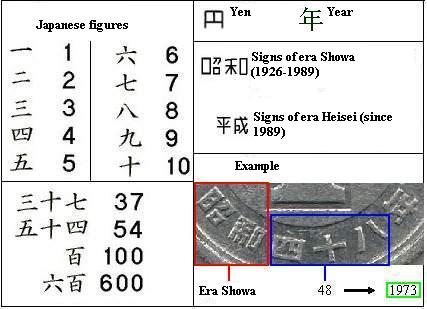Dating of the Japanese coins
The Japanese calendar is based on a traditional Chinese calendar. The account is conducted on 12 zodiac
animals or to "12 heavenly branches" (junishi). In parallel it the account goes as well on "10 terrestrial
runaways" (jikkan) - to the senior and younger symbols ("brothers") of natural elements (Tree, Fire,
Earth, Gold, Water).
| Elemlnts (jikkan) | Animals (junishi) |
|---|---|
ki-no-e (Senior Three)  |
ne (Mouse) |
ki-no-to (Younger Three) |
Usi (Bull) |
hi-no-e (Senior Fire)  |
Tora (Tiger) |
hi-no-to (Younger Fire) |
U (Hare) |
dzuti-no-e (Senior Earth) |
Tadzu (Dragon) |
dzuti-no-to (Younger Earth) |
Mi (Snake) |
ka-no-e (Senior Gold) |
Uma (Horse) |
ka-no-to (Younger Gold) |
Hidzuji (Sheep) |
midzu-no-e (Senior Water) |
Saru (Monkey) |
midzu-no-to (Younger Water) |
Tori (Cock) |
ki-no-e (Senior Three) |
Inu (Dog) |
ki-no-to (Younger Three) |
I (Wild boar) |
Thus, year is designated by two hieroglyphs - "jikkan" and "junishi". The full cycle at such dating makes 60 years. Cycle starts: 1024, 1084, 1144, 1204, 1264, 1324, 1384, 1444, 1504, 1564, 1624, 1684, 1744, 1804, 1864, 1924, 1984

Each Japanese emperor, ascending on a throne, approves the motto under which will pass its board. During ancient times emperor sometimes changed the motto if the beginning of board was unsuccessful.
In any case, the beginning of action of the motto of emperor is considered first year of new board, and the new era begins with it - the period of board under this motto. All mottos are unique, therefore they can be used as a universal scale of dating.
Era "Heisei" (Peace and Calmness), as well as board of emperor Akihito, has begun in 1989. Accordingly, 2006 - 18 year of era Heisei.
In days of restoration Meidzi (1868) the uniform system Japanese dating, originating in 660 year b.c. has been entered. - legendary date of the basis emperor Dzimmu of the Japanese state. That is 1868 on it dating was 2528. Actively this system was used only up to the end of the Second World war.
1868¢... Ś Modern epoch (Kindai)
- 1868¢30 july 1912 Ś era Meidzi (Mutzuhito empreror)

- 30 july 1912 Ń.¢25 december 1926 Ń. Ś era Taise (Yoshihito empreror)

- 25 december 1926 Ń.¢7 january 1989 Ń. Ś era Showa (Hirohito empreror)
- 7 january 1989 Ń.¢... era Heisei (Akihito empreror)

"nichi" (Sun) ![]() +
"hon" (Start)
+
"hon" (Start) ![]() = "Nippon" (Japan)
= "Nippon" (Japan)
ąźąŠčüčéąĖąĮą│ ąŠčé uCoz